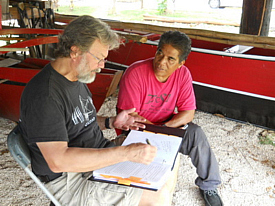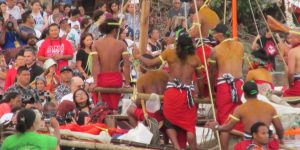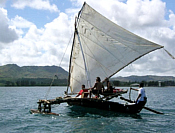Stories of the Pacific Islands
In the canoe house on Guam in about 2010, I meet with my teacher and mentor, the late Manny Sikau, a master navigator from Polowat Atoll. We are discussing the manuscript of my novel, Brothers of the Fire Star.
—————————————————————————————————————————————–
Moana, Disney’s just-released animated movie, tells the story of a Polynesian princess who, with a huge, tattooed demi-god by her side, sets out to save the world. The movie is significant because it is Disney’s first take on the all-important role voyaging–that is, sailing across long expanses of ocean in small outrigger or double-hulled canoes while navigating using only the stars, the sea, and the sky–played in settling islands of the vast Pacific. It is also significant because it casts a girl as the strong central character–a girl who becomes a navigator.
That last sentence is significant for me as a writer because the following story, which I wrote last spring for the 2016 Pacific Arts Festival before Moana was released, concerns just such a girl.
How a Girl Was the First Navigator
by
Douglas Arvidson
Author’s note: When I was living on my sailboat on Guam and studying traditional star-path navigation under Manny Sikau, a master navigator from Polowat Atoll, we discussed the fact that only men were allowed to become navigators. Manny then made brief mention of a Polowatese legend regarding women and navigation, saying only that according to this legend the daughter of an island chief was taught the secrets of navigation by a kulu bird. It was she who then taught those secrets to the men of Polowat. I have used this as the basis for imagining this short tale.
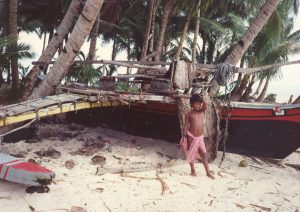
A boy sits by the side of the sea. What is around him? The sand is beneath him, the blue water is in front of him, behind him, the sky scudding with white clouds and wheeling sea birds and burning sun are above him.
But the boy is sad. His eyes are filled with tears, his heart aches, his spirit is broken. The canoes are gone. All the men of the island and all the boys, too, are gone. They have left this morning with the tide, sailing out of the lagoon on the good morning breeze. They have gone fishing. Even now he can see the canoes on the horizon, their sails cutting the sky, their dark shapes riding the blue swells.
He has been left behind on the beach because he is not a good fisherman, because he brings bad luck with him whenever he goes to sea. It is he who sees the octopus that portends bad luck. It is he who sees the floating bamboo that speaks of misfortune. The chief says the spirits of the ancestors have told him to leave the boy behind.
For a long time the boy sits in the sand crying in his great shame. The tide changes. It brings the water of the lagoon up closer to him, up to his feet. For a moment, the feeling of the water on his toes brings him out of his despair. He lifts his head and sees a bird. It is a kulu bird wading in the rising water, poking its narrow curved beak into the sand, looking for food. He watches the bird’s busy beak and its busy legs as it wades in the shallow water. It is walking towards him, ignoring him, eating and walking and poking its beak into the sand. The boy puts his head back down and closes his eyes. His despair and his sadness return and again his eyes fill with tears.
A moment later, he hears a voice. It is the sweet voice of a girl. He lifts up his head and looks all about but sees no one. Just the bird, eating, and walking, and poking its beak into the sand. Again he puts his head down, again he closes his eyes. Immediately he hears the voice and now he can see that it could only have been the bird—it is the bird that is speaking to him with the sweet voice of a young girl.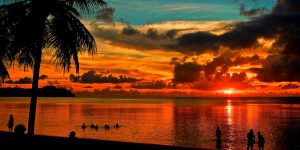
He watches and waits. The bird is close now. He can see its beautiful feathers, see the dark gray of its spindly legs, see the sparkling black of its eyes. He has never been able to get this close to a kulu bird before. Then the birds stops and looks right at him, looks directly into his eyes. And again he hears the voice and it is coming from the bird and he can understand its words. It says, “The answer to your sadness lies in the stars.”
“What?” the boy says.
“Meet me here tonight,” the bird answers. “When the star called Mailap, the Big Bird, rises above the edge of the world.”
The boy looked around to see if anyone had seen him talking to a bird but there was no one on the beach. When
Late in the day, the canoes come back from fishing. They have caught nothing. The men come and find the boy. “You have given us the evil eye as we left the lagoon,” they tell him. “You have ruined our fishing. Tomorrow when we leave you must stay in your house with your mother and sisters.” Again the boy is shamed. He hides in his house and cries himself to sleep.
When he wakes up, it is dark. Everyone is asleep. He hears a voice, the voice of the young girl that came from the kulu bird. It is calling to him. Quietly, he slips out of the house and walks to the beach, to the place where he had met the kulu bird the day before.
But he doesn’t see a bird. Instead he sees the shape of a young girl standing on the sand close to the water. It is a dark night, the sky is filled with stars. The starlight plays off the girl’s body and her eyes seem to sparkle with the star’s reflection off the water. She takes his hand and says, “Don’t be afraid. I am going to show you how the answer to your sadness, to your shame, lies in the stars.”
A moment later he feels himself rising from the beach. He feels light, he feels the air lifting him, feels the power of the stars on his face guiding him upwards. When he looks down at himself and at the girl, he sees that they have become kulu birds and they are flying together, higher and higher into the dark sky.
Together they fly across the lagoon and out above the shining sea. Again he hears the girls voice: “Now you must listen to the stars; they will speak to you. You must feel the stars; they will touch you. You must watch stars; they will guide you. If you do this, you will come to learn their great secrets.”
The boy does as he is told. He flies higher and higher. He listens, he feels, he watches. Soon it is not the girl who is speaking to him, but the stars. They tell him their names: “I am Wenewenen Fuhemwakut—the star-that-does-not-move”; “I am Mailap, known as the Big Bird. Under me the sun is born every morning”; “I am Wenewenen Up—the trigger fish. Under me lies the end of the world.”
The boy and the girl flew on through the night, listening to the stars, feeling their energies, watching their beautiful sparkling light, and the boy learned their many secrets: Where hidden islands lay, where there were reefs with many fish, where the many winds were born, and which stars were fighting stars that foretold of storms and bad weather.
When the stars began to fade and the sky began to lighten, portending the birth of the sun, the boy felt the morning wind on his face. He closed his eyes and when he opened them he was again standing on the beach by the lagoon. The stars and the girl were gone and the kulu bird, too, and the sun was rising above the sea.
He felt something around his neck. It was a long necklace of strongly woven coconut fiber and from the necklace hung a fishing hook made from a gleaming piece of seashell. He took the necklace off and unwound the long coconut fiber string. He hung on to one end of it and swung the hook out over the lagoon and watched it drop into the water. Immediately he felt the strong tug of a big fish. It took all his strength, but he pulled the fish up onto the beach and then again swung the hook back out into the water. Soon he had a pile of fish lying all around his feet.
It was then that the chief and the men and boys of the village came out of their houses and walked down to the water to get the canoes ready to go fishing. They saw the boy and the pile of fish. “What is this?” the chief asked.
“A kulu bird has given me this magic fishing line,” the boy said and again he swung the line over his head and as soon as the hook dropped into the water he caught a big fish.
That day the boy went fishing far out to sea with the men and boys of the village and they filled the canoes with fish. That night, they all sat on the beach together and looked at the sky and the boy told them what the kulu bird had taught him: how to use the stars to sail to islands that were hidden over the edge of the ocean, how to use the stars to find reefs full of fish, and how to use the stars to foretell the weather.
And that is how secrets of navigating the great sea were passed from the stars to human beings and how a girl was the first navigator.

